So, last time we talked about the Golden Age of Comics and the subsequent Silver Age of Comics — the era ruled over by the Comics Code Authority. When the Code loosened up in 1971, the world of comic books entered a new era: the Bronze Age of Comics. (I don’t know who decided that all these periods needed to be named like this, but…it’s getting to be a bit much, isn’t it?) The Code was still not ready for LGBTQ+ people to appear in the pages of comic books…but the people making underground comics did not care. They were ready to go for it — and queer artists, emboldened by the growing gay rights movement — were ready to push the envelope even farther.

In October of 1971, artist Rand Holmes tackled the homophobia in the book Everything You Ever Wanted to Know About Sex* (*But Were Afraid to Ask) — which we will some day talk about in greater detail some day when I tackle the sordid history of conversion therapy — stating that it sets psychiatry back by 50 years, and going so far as to have the lead character of his “The Continuing Adventures of Harold Hedd” engage in explicit oral sex with another man before blatantly calling out the book’s author David Reuben M.D. by saying “you are rilly fucked up man.” I’m not sure if word ever got back to David Reuben but the whole thing was a pretty fantastic call out.

The following year, the feminist comic book Wimmens Comix began its run — being published initially by Last Gasp though it would change hands over the years. As if to exemplify how much they did not care about the status quo, the first issue included a story called “Sandy Comes Out” by Trina Robbins — featuring the first openly lesbian character in comics. Despite breaking new ground, the comic was not especially well received by the LGBTQ+ community — in part because Trina Robbins is a straight woman, but mainly because it simplified the complexities of coming out. And so in 1974, Mary Wings entered the world of underground comix by self-publishing the entirely lesbian-focused book Come Out Comix.


1974 was also the year that Steve Glanzman’s story “Toro” was published — one of his U.S.S. Stevens stories that were printed in Our Fighting Forces by DC. Toro is a tragic story — and ostensibly a true on (as all of Glanzman’s war comics are believed to be), but there’s little question that the character it is about is not a straight man. Being published by a mainstream publisher, this was toeing the line of what the Code would allow. It managed to eke out a Code seal by never really going farther than referring to the character as a “fairy” in a way that might have implied that he was magic rather than gay.
Though 1975 was something of a quiet year — with the exception of a lesbian being introduced in the second issue of Further Fattening Adventures of Pudge, Girl Blimp by Lee Marrs, and the character Pudge getting almost arrested at a gay rights rally. Howver, 1976 was a banner year for gay comics. It kicked off in February with the first recurring openly gay character in mainstream comics — comic strips, that is — when Garry Trudeau introduced the character of Andy Lippincott to his daily strip Doonesbury.


That same year Howard Cruse had the continuing character of Headrack come out in the second issue of Barefootz Funnies. Headrack, while not the central character, was the best friend of the central character and so was a continuous presence in the series. Which meant, officially, the first gay recurring character had appeared in comic strip and comic book format. Pretty important, but there was more ahead for 1976. Roberta Gregory — one of the contributors to Wimmen’s Comix — began self-publishing her own work, centered around lesbian characters, called Dynamite Damsels and Larry Fuller put together an anthology series featuring all gay male characters called Gay Heart Throbs. All of these, of course, were underground comic that did not need to meet the Code’s standards and intentionally did not. So, despite the fact that 1976 was a pretty impressive, groundbreaking year….most of the United States only knew about Andy Lippincott.
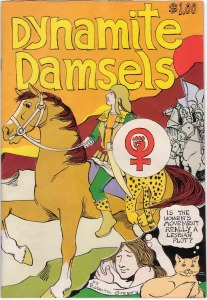


In 1977, Gerard Donelan (often just called “Donelan”) — a fan of Joe Johnson‘s cartoons — submitted work to The Advocate, disappointed that they weren’t continuing to run Johnson’s work. After they ran his first cartoon, they hired him to create a regular strip called “It’s a Gay Life” — which would run for 15 years. This, perhaps, was the inspiration Rupert Kinnard needed to begin creating “Cathartic Comics” for Cornell College’s student newspaper, which featured the Brown Bomber and Diva Touché Flambé — the first gay and lesbian (respectively) black characters in comics. This is often overlooked, because there’s no actual crime fighting or supervillains in the strips, but Brown Bomber is also the first gay superhero — he transforms into his superheroic identity through the power of magic hiccups. Of course.


The following year, a book of gay cartoons from the magazine Christopher Street was released. It was advertised as “The World’s First Gay Cartoon Book!” which, as we’ve seen, was not strictly speaking true. But I’m including it in this article primarily because the title of the book makes me laugh every time I see it: And God Bless Uncle Harry and His Roommate Jack Who We’re Not Supposed to Talk About. Other gay magazines, such as In Touch For Men would also soon release their own cartoon collections in 1978. But without the funny titles.
Meanwhile, still in 1978, DC was working hard to counteract various rumors about some of their characters being gay. To that end, they introduced a woman named Shvaughn Erin — an officer of the Science Police, very capable woman — to be the love interest of Element Lad who had been continuously subjected to rumors of being gay since his creation. Despite this, the rumors persisted. It’s like the people at DC had never heard of a beard before.


Anyways, with queer cartoonists taking the lead in telling queer stories with underground comix, Denis Kitchen decided his publishing company, Kitchen Sink Press, could help get those stories out there even more. In 1979, he asked Howard Cruse to help him put together Gay Comix — an anthology series exclusively featuring LGBTQ+ stories by openly LGBTQ+ artists. Gay Comix would run for 26 issues, ending its run in 1998. It would go on to feature Jerry Mills‘ series “Poppers,” and so many others I could probably write a whole article just on it.
By 1980, the Code itself had lost much of its sway. Major publishers were starting to get books sold at comic book stores without with the CCA seal, simply by marketing them as “for mature audiences”, and the CCA was putting its stamp on books that would never have been allowed before. Eclipse Comics published the graphic novel Detectives Inc.: A Remembrance of Threatening Green (by Don McGregor), which featured lesbian characters and Stewart the Rat (by Steve Gerber) which also featured a little bit of queer content. Even Marvel, I guess, tried to dabble in queer content. Kind of. It was a deeply offensive story (especially if its your first time having gay men in a story) called “A Personal Hell” from Hulk! #23, written by Jim Shooter. Again, deeply offensive, so we’re going to breeze on past it. I wish we could pretend it never happened but….we’re not done with Jim Shooter yet.
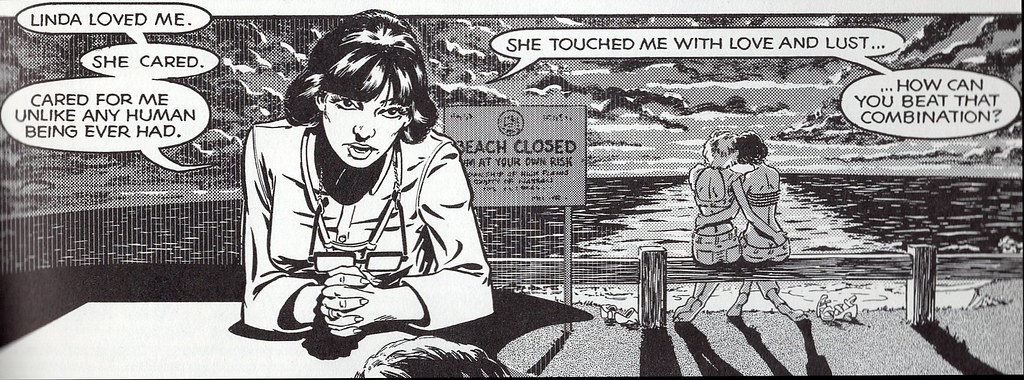

Kitchen Sink Press and Eclipse Comics both, apparently, discovered they could make money from unabashedly presenting queer characters. In 1981, Kitchen Sink Press introduced a recurring strip called “Omaha, the Cat Dancer” in its anthology series Bizarre Sex. Several characters engaged in homosexual activities throughout the course of the strip, but it kicked off with the openly bisexual character Shelley Hine in that very first strip.
Also in 1982, Marvel comics tried the whole “gay characters” thing again, with much more success. They introduced the character Arnie Roth, who had been friends with Steve Rogers before he became a superhero, defending him from neighborhood bullies. Arnie ran into Captain America, revealing that he had long ago guessed Cap’s secret identity. Captain America and Arnie set off on an adventure to rescue Arnie’s “roommate” Michael Bech. When they succeed and Arnie and Michael are reunited, Captain America figures out pretty quickly that they’re actually a couple. It’s a sweet little story, and gives Arnie Roth the distinction of being Marvel’s first gay character. And, because he’s a minor character and he’s not shown kissing, and because Michael is consistently called his “roommate”…he also has the distinction of being the first gay character to have his story told with a CCA seal of approval. (Marvel made a recent announcement regarding Captain America while I was researching this…which I found particularly interesting because of this…but that’s for the end of this series. If I talked about it while it was news, it wouldn’t be history, right?)
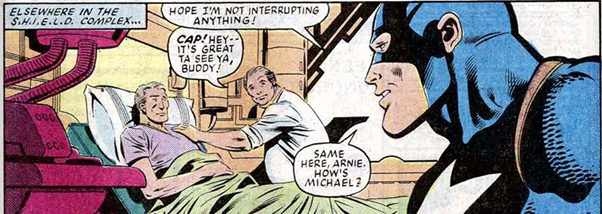

DC began publishing stories without the CCA seal — marketing them as being for “mature readers.” These included Camelot 3000, in which the Knights of the Round Table are reincarnated in the year 3000 AD. The knight Sir Tristan, when his memories awaken, finds he has been reincarnated in the body of a woman named Amber. Tristan gets more upset when he discovers Isolde, his great love, has also been reincarnated…also as a woman. Isolde helps Tristan come to terms with the situation and the two become lovers again. Despite the fact that Tristan has kind of medieval attitudes about sex, gender, and sexuality (which is kind of understandable since Tristan is from that time period) it’s actually like pretty good transgender representation. A gigantic leap forward since the last major transgender representation in comics was decades earlier and was….oh right….a bored guy on Mars.
Also in 1982, something new and important happened very quietly in the underground comix scene. Gay Comix #3 incuded a story entitled “I’m Me!” by David Kottler appeared, his only credited work in comics of any kind, at least under that name (as far as I’ve found). The story is a brief one about his transition. David seems to have been the first openly transgender comic creator and the first to tell a story about an actually transgender person (not some wacky sci-fi/fantasy genderbending hijinks) in that format.

Not to be outdone, in December of that year, Eclipse Comics series SABRE by Don McGregor introduced two gay characters, named Deuces Wild and Summer Ice, who were presented as lovers basically as soon as they appeared. A year later, the same series featured the first gay kiss in mass-produced comics — by the same characters, unsurprisingly. Underground comix had, of course, had plenty of gay kisses by this point, but those were not mass produced by any definition. Eclipse Comics was operating somewhere between underground and mainstream — they were able to mass produce comics but, obviously, did not care at all about the Code. Their books would sell anyways.

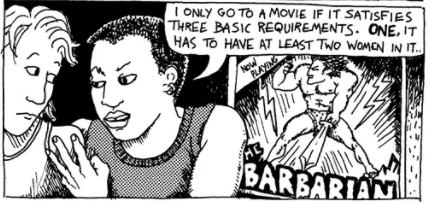
1983 was also the year that Alison Bechdel began publishing her comic strip series “Dykes to Watch Out For” in the magazine Womannews. If Bechdel’s name sounds familiar, that’s either because you already know her work, you love the Broadway musical Fun Home, or because the Bechdel Test is widely used to sort of gauge the quality of female representation in pieces of media. The test — if you haven’t heard of it — is basically, are there two named female characters who speak about something other than a man. That test is named after her, despite her crediting her friend Liz Wallace for the idea, because it was first described in — you probably guessed this already — the strip “Dykes to Watch Out For.” (But not until 1985, at which point Bechdel was self-syndicating the strip.) The strip would run continuously until 2008, at which point Bechdel decided to retire it, except for occasional special ones like the “Postcards from the Edge” story she published in 2017 for the “Ides of Trump” campaign.
Bechdel was not the only queer artist putting out new, gay work in 1983, however. In the UK, David Shenton published his first graphic novel, Stanley and the Mask of Mystery. Howard Cruse, though still producing Gay Comix began publishing a strip called “Wendel” in issues of The Advocate, and the series “Jayson” by Jeff Krell began appearing in Philadelphia Gay News (it would later be published in Gay Comix and Meatmen as well.)
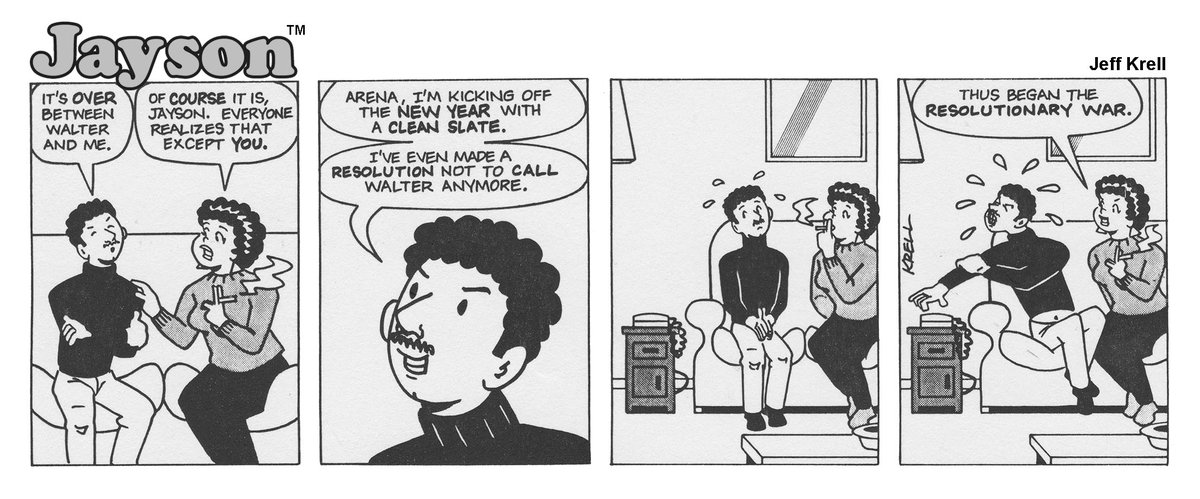
Also in 1983, was the first issue of Alpha Flight — a Marvel comic book series about a Canadian superhero team. They’d been introduced as enemies of the X-Men back in 1979, but now they were getting their own series. And one of their founding members was Northstar. Now, one of the problems with taking bad guys from a single comic book issue four years prior and making them stars of their own book series was….you had to make up backstories for them. Creator John Byrne was convinced that Northstar was a closeted Olympic athlete — and also secretly a superhero, and was determined to tell that story. Now, the Code and also executives at Marvel — primarily editor-in-chief Jim Shooter (I told you we weren’t done with him) — prevented him from telling it as plainly as he’d have liked. It’s been said that Shooter was determined to have “no gays in Marvel Comics.” The comics were full of hints about how Jean-Paul Beaubier (that’s Northstar’s secret identity) was too busy with Olympic training to be interested in girls, how he would ignore his throngs of female fans, etc. Like, it wasn’t spelled out but it was hard to miss. But outside of the pages of the comic, Byrne would tell pretty much anyone that Northstar was gay. As a result, Northstar is pretty widely considered to be the first gay superhero from a mainstream comic book publisher (despite not actually be out in the comic book).


But one thing Marvel did manage to do in this year without any concern about the Code was to use the word “gay” — meaning homosexual — for the first time in a mainstream comic book. It’s a subtle little thing — a bit of dialogue I’m sure many straight women will have lived through themselves. It appears in Fantastic Four #251, when the characters of Julie D’Angelo and Sharon Selleck are discussing their new friend Grey Landers (whom Julie is all about) right before Johnny Storm — the Human Torch — comes over to ask her out. They’re setting up a whole love……some sort of geometric shape….but, alas, a purely heterosexual one.

The next year, in Vigilante #5 DC introduced the freelance mercenaries Henry Cannon and Marschall Saber (or simple, Cannon and Saber). Although their being a gay couple was presented as like a minor detail that didn’t matter, probably to sneak it by the Code, really the whole plotline wouldn’t work if they were not. Despite the subtlety, they didn’t get this approved by the Code. The story is, basically, that a D.A. has arranged for them to go into witness protection together if they kill each other’s bosses. They do so, but before they can be entered into Witness Protection, they get attacked in their home by the Vigilante. In the ensuing fight, Cannon and Saber were actually winning until the fight was interrupted by the Electrocutioner. The story almost managed to get a CCA seal, primarily because the gay characters were villains but their relationship is actually pretty wholesome — they work as a team, they protect each other over anything else, and they support each other’s goals. There are good guy gay couples in the media now that don’t have relationships this healthy.

Marvel, meanwhile, revealed that their character Cloud was transgender…..uhm….kind of. You see, they introduced a plotline wherein Cloud was falling in love with Moondragon, one of her female teammates on the Defenders…..so she began shapeshifting into a man. This story did not get approved by the Code, but still managed to get sold in stores. Some stores, anyways. It would later turn out that Cloud was actually a nebula from space that had taken on human form, lost their memories, and become a superhero. The Marvel Database officially lists Cloud as “genderfluid” and, in this sense, that’s pretty literal. Still don’t think this storyline was quite up to par with the one in Camelot 3000 but that’s not up to me, is it?
There was a bit of a minor shakeup in the comic book world, as two new publishing companies were trying to make room for themselves in the industry. One of them was Megaton Comics — who we’ll follow up with later — and the other was First Comics. Among the various hurdles First Comics was dealing with was their own unwillingness to abide by the rules of the Code. For example, in Sable (vol 1) #15, the lead character Jon Sable assured Grey Adler, his love interest’s best friend, that he didn’t judge homosexuals. Grey would become a major recurring character, leading Sable into various adventures pertaining to issues facing the gay community.
Though Marvel and DC were just beginning to put their toes into the big LGBTQ+ representation pool, the underground comics scene was really getting the hang of it. 1984 was the year that Tim Barela debuted his strip “Leonard & Larry” in Gay Comix. The strip would later also be published in The Advocate and Frontiers — and it would run in Frontiers until 2002! The strip featured a wide variety of characters, all falling under the LGBTQ+ umbrella, and was praised for its depiction of queer families and for the fact that the characters in it aged realistically over the years.
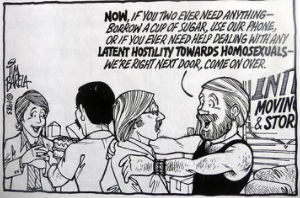
By the end of 1984, there had been at least one queer character introduced in virtually every area of comics — there was still a long, long, long way to go between where we were then and where we are now (and where we still need to go!). And we’ll go over more of that journey in the exciting next episode!

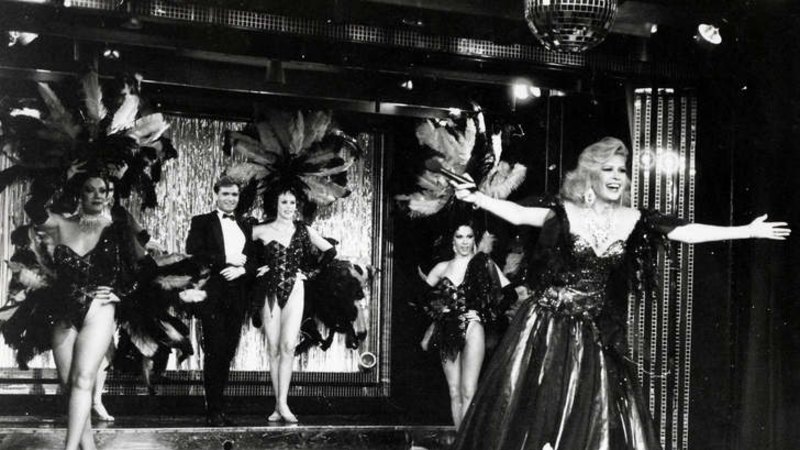
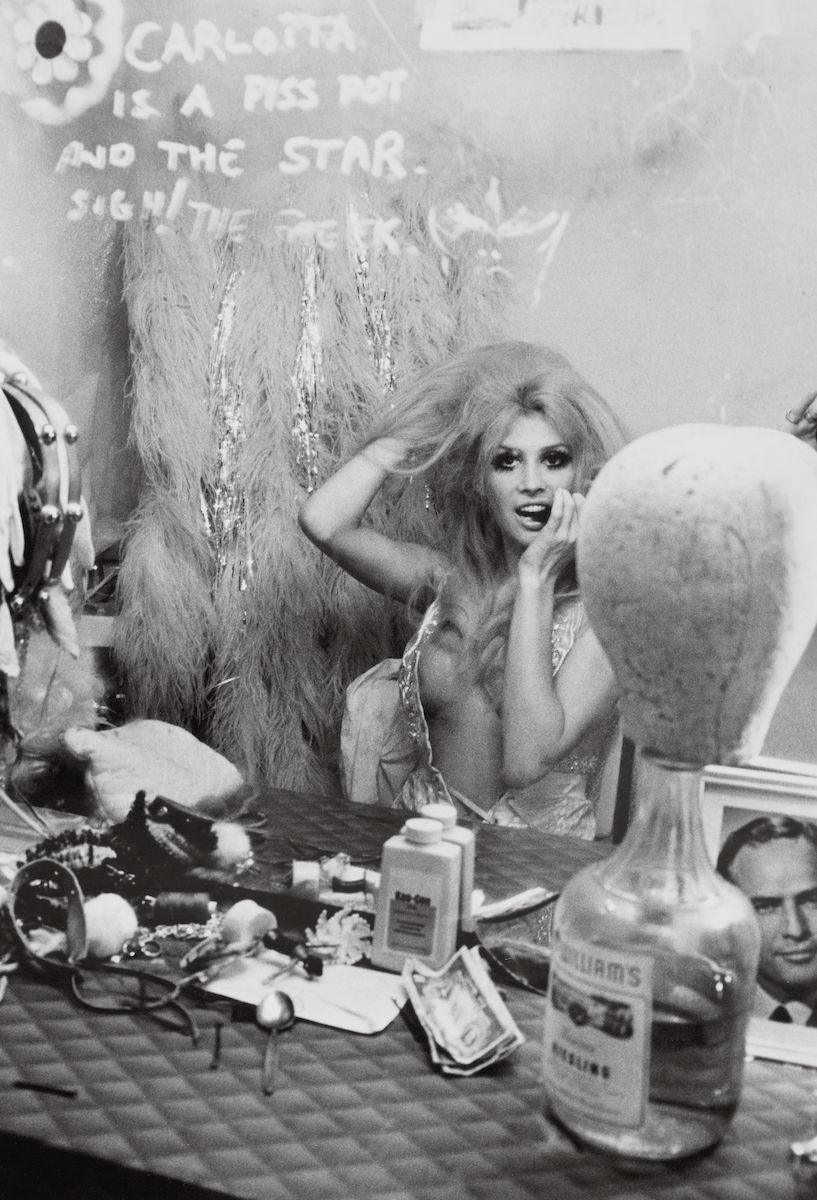
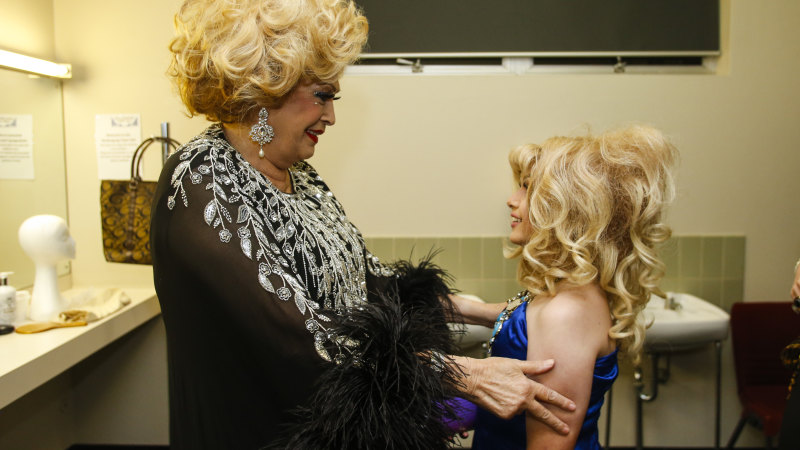



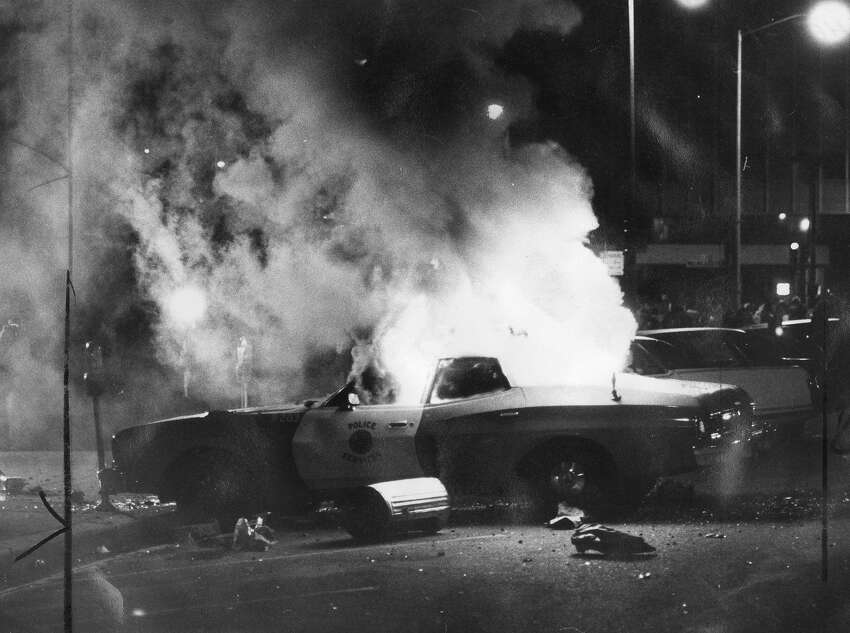


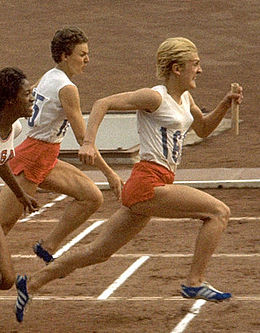 In more recent years, many governments and organizations have worked to undo the injustice that’s been committed against LGBTQIA+ people throughout history — pardoning those convicted of homosexuality or cross-dressing when those were crimes, writing obituaries for notable queer people in history, etc. But there’s some glaring instances where an injustice clearly could and should be rectified — but no justice has been forthcoming. One egregious example of this is that of Ewa Kłobukowska.
In more recent years, many governments and organizations have worked to undo the injustice that’s been committed against LGBTQIA+ people throughout history — pardoning those convicted of homosexuality or cross-dressing when those were crimes, writing obituaries for notable queer people in history, etc. But there’s some glaring instances where an injustice clearly could and should be rectified — but no justice has been forthcoming. One egregious example of this is that of Ewa Kłobukowska.
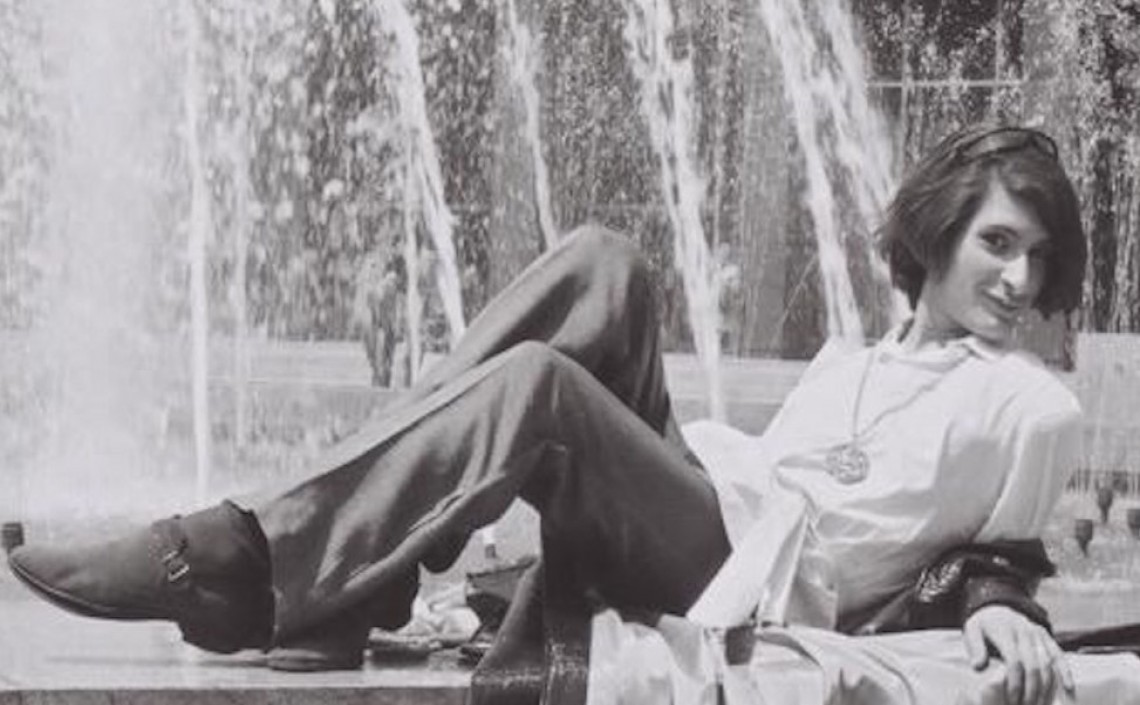 Of all of the heroes of the LGBTQIA+ community who fought for us at the Stonewall Riots, I personally think that Sylvia Rivera may have had the most important impact on our community — however, she may also be the most controversial. Though we view her as a hero and champion for our community now, she was not always looked on so fondly.
Of all of the heroes of the LGBTQIA+ community who fought for us at the Stonewall Riots, I personally think that Sylvia Rivera may have had the most important impact on our community — however, she may also be the most controversial. Though we view her as a hero and champion for our community now, she was not always looked on so fondly.
 Despite her friction with many queer organizations, Rivera was an active member of the Metropolitan Community Church of New York, and often helped to feed the poor and homeless through their food pantry. In 2000, Rivera traveled to Rome, Italy for WorldPride. There she was called “the mother of all gay people” and participated in the Millenium March. In 2001, Rivera attempted to revive STAR as a political organization — changing the “T” to stand for “Transgender,” which was beginning to come into common usage. The new STAR, under Rivera’s leadership, pushed for a trans-inclusive New York State Sexual Non-Discrimination Act, as well as the New York City Transgender Rights Bill. They also fought for justice for Amanda Milan, a transgender woman who was murdered in 2000.
Despite her friction with many queer organizations, Rivera was an active member of the Metropolitan Community Church of New York, and often helped to feed the poor and homeless through their food pantry. In 2000, Rivera traveled to Rome, Italy for WorldPride. There she was called “the mother of all gay people” and participated in the Millenium March. In 2001, Rivera attempted to revive STAR as a political organization — changing the “T” to stand for “Transgender,” which was beginning to come into common usage. The new STAR, under Rivera’s leadership, pushed for a trans-inclusive New York State Sexual Non-Discrimination Act, as well as the New York City Transgender Rights Bill. They also fought for justice for Amanda Milan, a transgender woman who was murdered in 2000.
 Although she regularly said her middle initial stood for “Pay it no mind”, Marsha P. Johnson proved to be a difficult person not to notice. Though Johnson is commonly referred to using female pronouns (she/her/hers) — and I’ll be doing that here — her actual gender identity is a bit of a mystery. She variously described herself as gay, a transvestite, and as a (drag) queen — though words like “transgender” really weren’t being widely used yet during her lifetime. My personal opinion is that she would probably identify as gender non-conforming or non-binary, but make your own judgments.
Although she regularly said her middle initial stood for “Pay it no mind”, Marsha P. Johnson proved to be a difficult person not to notice. Though Johnson is commonly referred to using female pronouns (she/her/hers) — and I’ll be doing that here — her actual gender identity is a bit of a mystery. She variously described herself as gay, a transvestite, and as a (drag) queen — though words like “transgender” really weren’t being widely used yet during her lifetime. My personal opinion is that she would probably identify as gender non-conforming or non-binary, but make your own judgments.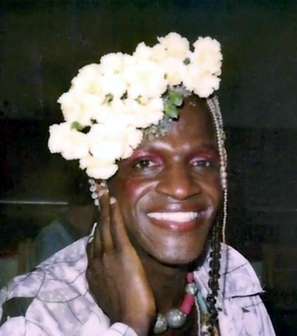 She also began to perform as a drag queen — initially going by the name “Black Marsha” before settling on Marsha P. Johnson. She was often recognizable for having flowers in her hair — something she began doing after sleeping under flower sorting tables in Manhattan’s Flower District. She usually had on bright colored wigs, shiny dresses, and long flowing robes. Marsha was known to be peaceful and fun, but there was a violent and short-tempered side to her personality (which her friends commonly called “Malcolm”) — leading some to suspect that she suffered from schizophrenia. Between her sex work and her occasional violent outbursts, Johnson claimed to have been arrested more than a hundred times.
She also began to perform as a drag queen — initially going by the name “Black Marsha” before settling on Marsha P. Johnson. She was often recognizable for having flowers in her hair — something she began doing after sleeping under flower sorting tables in Manhattan’s Flower District. She usually had on bright colored wigs, shiny dresses, and long flowing robes. Marsha was known to be peaceful and fun, but there was a violent and short-tempered side to her personality (which her friends commonly called “Malcolm”) — leading some to suspect that she suffered from schizophrenia. Between her sex work and her occasional violent outbursts, Johnson claimed to have been arrested more than a hundred times. In 1973, Johnson also performed with the Angels of Light drag troupe — taking on the role of “The Gypsy Queen” in their production of “The Enchanted Miracle”. That same year both Johnson and Rivera were banned from participating in New York’s gay pride parade — the committee organizing the parade felt that drag queens and transvestites brought negative attention and gave the cause “a bad name.” In response, Rivera and Johnson marched ahead of the beginning of the parade.
In 1973, Johnson also performed with the Angels of Light drag troupe — taking on the role of “The Gypsy Queen” in their production of “The Enchanted Miracle”. That same year both Johnson and Rivera were banned from participating in New York’s gay pride parade — the committee organizing the parade felt that drag queens and transvestites brought negative attention and gave the cause “a bad name.” In response, Rivera and Johnson marched ahead of the beginning of the parade. In 1975, Andy Warhol took pictures of Johnson for his “Ladies and Gentlemen” series. Johnson’s success as an activist and a performer, as well as her regular appearances throughout the decade, earned her the nickname “Mayor of Christopher Street.”
In 1975, Andy Warhol took pictures of Johnson for his “Ladies and Gentlemen” series. Johnson’s success as an activist and a performer, as well as her regular appearances throughout the decade, earned her the nickname “Mayor of Christopher Street.”
 During the 90’s, after many years of this, she developed an infection in her leg that ultimately put an end to her travels. She was admitted to a hospital in Bolzano, and afterwards stayed in a newly opened homeless shelter for women that had recently opened there. In 2012, she was given a place to stay at the Villa Armonia nursing home in the same city. Mariasilvia was not eager to give up her freedom, and adamantly refused to do anything but sleep inside the nursing home for the first three years then. After those first years though, she warmed to the idea and began to participate in picking the movies for theme nights, having meals with the other residents, and taking pictures of them all. Eventually, she even gave the books she had been traveling with for decades to the nursing home’s library. She remained there until she passed away at 83 years old on October 31, 2018. She died still estranged from her family and, sadly, forgotten by many despite the momentous act that cost her so much.
During the 90’s, after many years of this, she developed an infection in her leg that ultimately put an end to her travels. She was admitted to a hospital in Bolzano, and afterwards stayed in a newly opened homeless shelter for women that had recently opened there. In 2012, she was given a place to stay at the Villa Armonia nursing home in the same city. Mariasilvia was not eager to give up her freedom, and adamantly refused to do anything but sleep inside the nursing home for the first three years then. After those first years though, she warmed to the idea and began to participate in picking the movies for theme nights, having meals with the other residents, and taking pictures of them all. Eventually, she even gave the books she had been traveling with for decades to the nursing home’s library. She remained there until she passed away at 83 years old on October 31, 2018. She died still estranged from her family and, sadly, forgotten by many despite the momentous act that cost her so much. Alright, let’s talk about the Compton’s Cafeteria riot, which took place in August of 1966 in San Francisco. At the time, transgender people were not welcome in gay bars because the police were able to use the presence of cross-dressing individuals as probable cause in order to raid a bar — and also because, let’s face it, there is *still* transphobia in the LGBTQ+ community. So instead of going to gay bars, the transgender community of San Francisco frequented one of Gene Compton’s Cafeterias, this one located at 101 Taylor Street. (The cafeteria there closed its doors in 1972.)
Alright, let’s talk about the Compton’s Cafeteria riot, which took place in August of 1966 in San Francisco. At the time, transgender people were not welcome in gay bars because the police were able to use the presence of cross-dressing individuals as probable cause in order to raid a bar — and also because, let’s face it, there is *still* transphobia in the LGBTQ+ community. So instead of going to gay bars, the transgender community of San Francisco frequented one of Gene Compton’s Cafeterias, this one located at 101 Taylor Street. (The cafeteria there closed its doors in 1972.)
